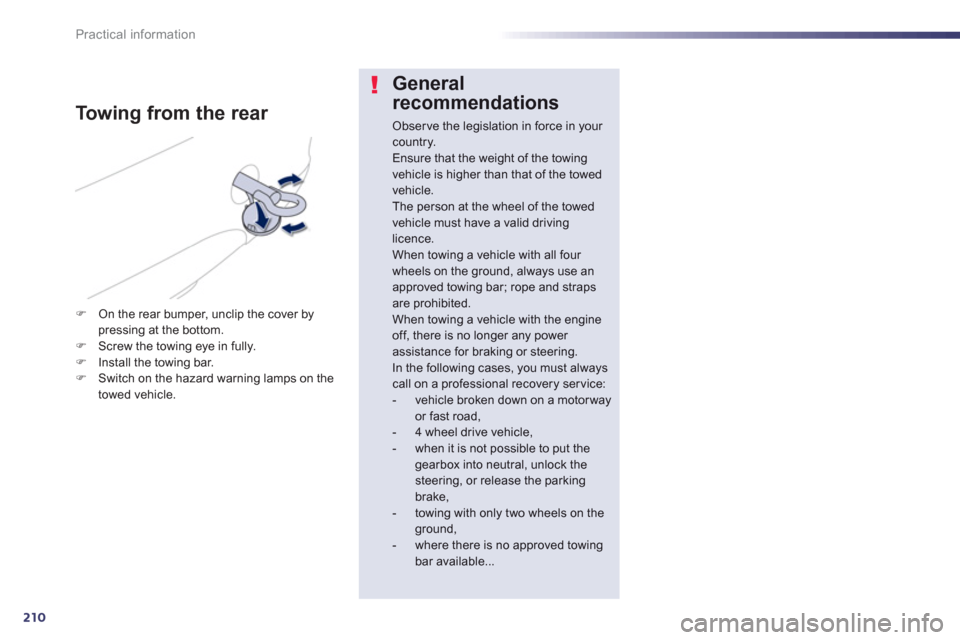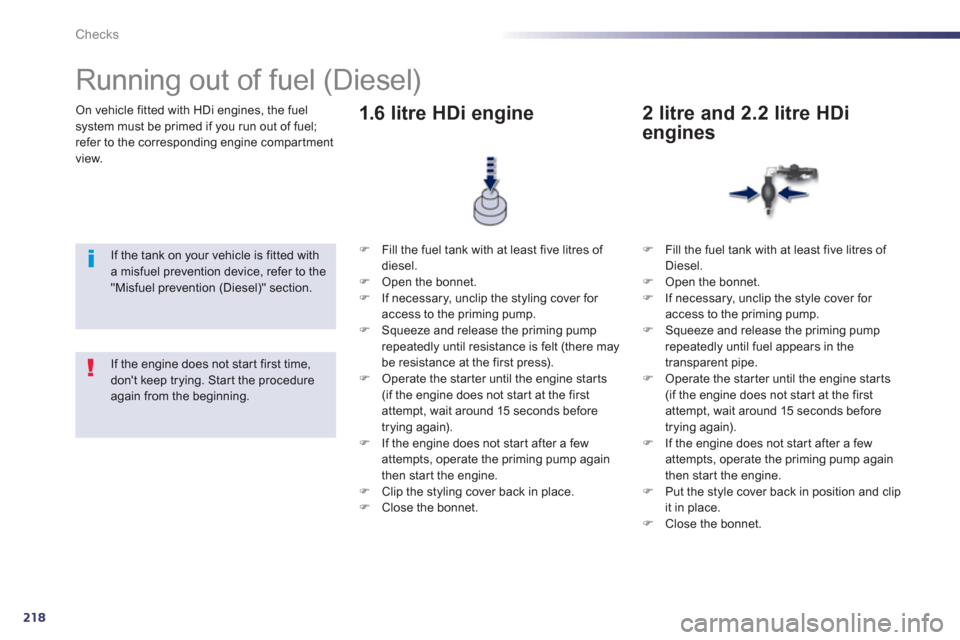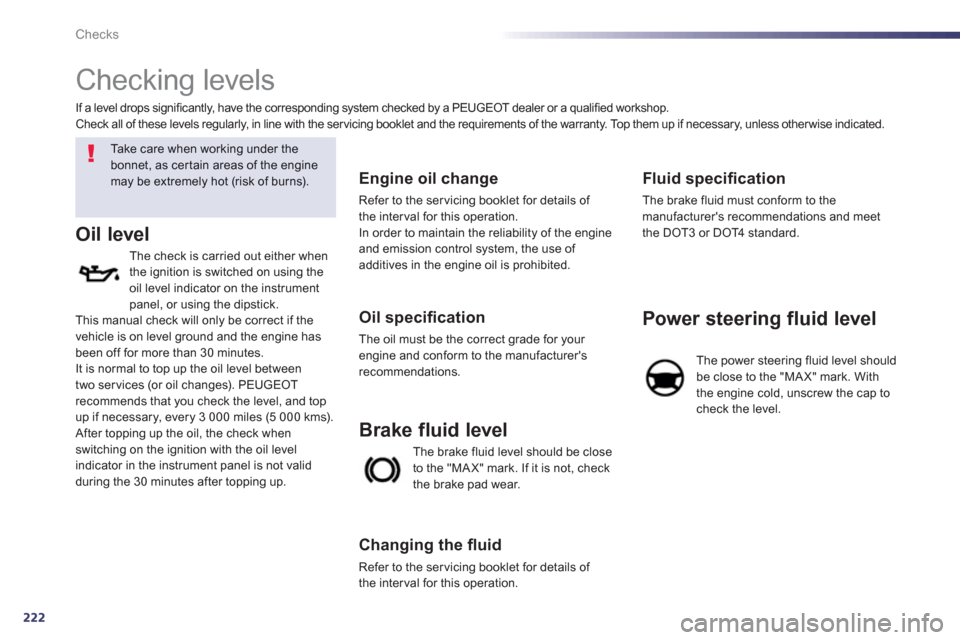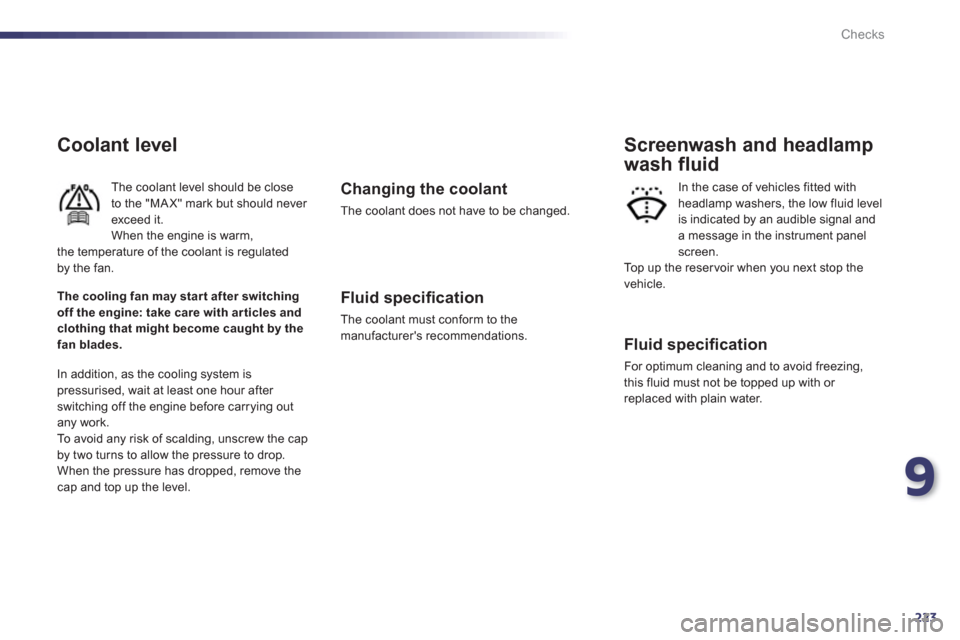Page 212 of 340

210
Practical information
General
recommendations
Observe the legislation in force in your country.Ensure that the weight of the towing vehicle is higher than that of the towedvehicle.The person at the wheel of the towedvehicle must have a valid driving licence.When towing a vehicle with all four wheels on the ground, always use an approved towing bar; rope and straps are prohibited. When towing a vehicle with the engine off, there is no longer any power assistance for braking or steering.In the following cases, you must always call on a professional recovery service:- vehicle broken down on a motor wayor fast road,
- 4 wheel drive vehicle, - when it is not possible to put the gearbox into neutral, unlock thesteering, or release the parkingbrake, - towing with only two wheels on theground, - where there is no approved towing bar available...
To w i ng from the rear
FOn the rear bumper, unclip the cover by pressing at the bottom. FScrew the towing eye in fully. FInstall the towing bar.FSwitch on the hazard warning lamps on the
towed vehicle.
Page 214 of 340

212
Practical information
Driving advice
Distribution of loads
FDistribute the load in the trailer so that theheaviest items are as close as possible to
the axle and the nose weight approaches
the maximum permitted without
excee
ding it.
Air density decreases with altitude, thus reducingengine performance. Above 1 000 metres, the maximum towed load must be reduced by 10 %
for every 1 000 metres of altitude.
Side wind
FTake into account the increased sensitivity
to side wind.
Cooling
To w i ng a trailer on a slope increases the
temperature of the coolant.
As the fan is electricall
y controlled, its cooling capacity is not dependent on the engine speed.
F
To lower the engine speed, reduce your speed.
The maximum towed load on a long incline
depends on the
gradient and the ambient
temperature.
In all cases, keep a check on the coolant
temperature.
FIf the warning lamp and the
STOP warning lamp come on, stop the vehicle and switch off
the engine as soon as possible.
Braking
To w i ng a trailer increases the braking distance.
To avoid overheating of the brakes on a longmountain type of descent, the use of engine braking is recommended.
Tyres
F
Check the tyre pressures of the towingvehicle and of the trailer, obser ving the recommended pressures.
Lighting
F
Check the electrical lighting and signalling on the trailer.
The rear parking sensors will be deactivated automatically if a genuine PEUGEOT towbar is used.
R
efer to the "Technical Data" section for details
of the weights and towed loads which apply to your vehicle.
Page 220 of 340

218
Checks
On vehicle fitted with HDi engines, the fuelsystem must be primed if you run out of fuel; refer to the corresponding engine compar tment
view.
Running out of fuel (Diesel)
If the tank on your vehicle is fitted witha misfuel prevention device, refer to the "Misfuel prevention (Diesel)" section.
F
Fill the fuel tank with at least five litres of diesel. F
Open the bonnet.F
If necessary, unclip the styling cover for
access to the priming pump. F Squeeze and release the priming pump
repeatedly until resistance is felt (there may
be resistance at the first press). F Operate the star ter until the engine starts(if the engine does not star t at the first
attempt, wait around 15 seconds before
trying again).
F If the engine does not star t after a few
attempts, operate the priming pump again
then start the engine. F Clip the styling cover back in place. F
Close the bonnet.
1.6 litre HDi engine
F
Fill the fuel tank with at least five litres of
Diesel.F Open the bonnet. F
If necessary, unclip the style cover for access to the priming pump. F
Squeeze and release the priming pump repeatedly until fuel appears in the
transparent pipe. F Operate the star ter until the engine star ts (if the engine does not star t at the first attempt, wait around 15 seconds before
trying again).
F If the engine does not star t after a few attempts, operate the priming pump again
then start the engine. F Put the style cover back in position and clip it in place.F
Close the bonnet.
2 litre and 2.2 litre HDi
engines
If the engine does not star t first time, don't keep trying. Star t the procedureagain from the beginning.
Page 221 of 340
9
219
Checks
The various caps and covers allow access for checking the levels of the various fluids and for
replacing cer tain components.
Petrol engines
1.
Power steering reservoir.2.Screenwash and headlamp wash reservoir.3.Coolant reservoir.4.
Brake fluid reservoir.
5. Battery / Fuses.
6.Fusebox.
7. Air filter.8.Engine oil dipstick.9.
Engine oil filler cap.
1.6 litre 16V VTi 120 hp
1.6 litre 16V THP 155 hp
Page 222 of 340
220
Checks
checking the levels of the various fluids, for replacing cer tain components and for primingthe fuel system.
*
Accordin
g to engine.
Diesel engines
1.
Power steering reservoir.2.
Screenwash and headlamp wash reservoir.3.
Coolant reservoir. 4.
Brake fluid reservoir.5.
Battery / Fuses.
6.Fusebox.
7. Air filter.8.Engine oil dipstick. 9.
Engine oil filler cap.10.Priming pump * . 11.
Bleed screw *
. 1.6 litre HDi 110 hp
2.0 litre HDi 140 hp
Page 223 of 340
9
221
Checks
The various caps and covers allow access for checking the levels of the various fluids, for
replacing cer tain components and for primingthe fuel system.
*
According to engine.
Diesel engines
1.
Power steering reservoir.2.Screenwash and headlamp wash reservoir.3.Coolant reservoir.4.
Brake fluid reservoir.
5. Battery / Fuses.
6.Fusebox.
7. Air filter.8.Engine oil dipstick.9.
Engine oil filler cap.10.Priming pump * . 11.
Bleed screw *
. 2.0 litre HDi 163 hp
2.2 litre HDi 200 hp
Page 224 of 340

222
Checks
Checking levels
Ta k e c a r e w h e n w o r k i ng under the
bonnet, as certain areas of the enginemay be extremely hot (risk of burns).
Oil level
The check is carried out either when
the ignition is switched on using the oil level indicator on the instrument panel, or using the dipstick.
This manual check will only be correct if the
vehicle is on level ground and the engine has
been o
ff for more than 30 minutes.
It is normal to top up the oil level between
two ser vices
(or oil changes). PEUGEOTrecommends that you check the level, and top
up if necessary, every 3 000 miles (5 000 kms).
After topping up the oil, the check whenswitching on the ignition with the oil levelindicator in the instrument panel is not validduring the 30 minutes after topping up.
Engine oil change
Refer to the ser vicing booklet for details ofthe inter val for this operation.
In order to maintain the reliability of the engine
and emission control system, the use of
additives in the engine oil is prohibited.
Oil specifi cation
The oil must be the correct grade for your engine and conform to the manufacturer'srecommendations.
Th
e brake fluid level should be close
to the "MA X" mark. If it is not, check
the brake pad wear.
Brake fluid level
Changing the fl uid
Refer to the ser vicing booklet for details ofthe inter val for this operation.
Fluid specifi cation
The brake fluid must conform to themanufacturer's recommendations and meet
the DOT3 or DOT4 standard.
Power steering fluid level
The power steering fluid level shouldbe close to the "MAX" mark. With
the engine cold, unscrew the cap to
check the level. I
f a level drops significantly, have the corresponding system checked by a PEUGEOT dealer or a qualified workshop. Check all of these levels regularly, in line with the ser vicing booklet and the requirements of the warranty. Top them up if necessary, unless other wise indicated.
Page 225 of 340

9
223
Checks
Coolant level
The coolant level should be closeto the "MA X" mark but should never exceed it.When the engine is warm,
the temperature of the coolant is regulated
by the fan.
In addition, as the cooling system is
pressurised, wait at least one hour after switching off the engine before carrying out
any work.
To avoid an
y risk of scalding, unscrew the cap
by two turns to allow the pressure to drop.When the pressure has dropped, remove thecap and top up the level.
Changing the coolant
The coolant does not have to be changed.
Fluid specifi cation
The coolant must conform to the
manufacturer's recommendations.
Fluid specifi cation
For optimum cleaning and to avoid freezing,
this fluid must not be topped up with or
replaced with plain water.
Screenwash and headlamp
wash fluid
In the case of vehicles fitted with
headlamp washers, the low fluid level is indicated by an audible signal anda message in the instrument panelscreen.
Top up the reser voir when you next stop the
vehicle. The cooling fan may star t after switchingoff the engine: take care with ar ticles andclothing that might become caught by thefan blades.